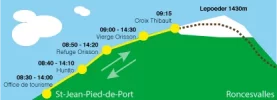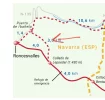Bless your heart, Getting There. Do not allow fear or anxiety to dictate how you want to proceed. Lots of folks walk from St. Jean to Roncesvalles; some have their backpacks transported to help lighten their steps. Others only do half way to the Virgen de Orisson and then take a taxi back to St Jean for the night, and then taxi back to where they left off. Others stop at Orrison or Borda.
But if you want to try and see how it goes, here are some tips that may help.
--------------------------------
If a person has some level of cardio fitness, making it up a long uphill grade is a matter of pace, maintaining calorie intake, hydration, and utilizing meaningful breaks.
1. As you head uphill, adjust your pace to a comfortable level which you are able to maintain without needing to frequently stop and start. Frequent stops and starts adds to exhaustion. It doesn't matter if your pace is 4 miles per hour or 0.5 miles per hour. What matters is continuously walking between planned breaks.
Set a planned interval for a short and deliberate break -- say every 20 minutes, lasting for five minutes. Set your pace so that you can walk until reaching break time.
Setting your pace is a
dynamic process, you need to adjust it as circumstances dictate. Please set your pace based on what you
need, not on how you
feel.
How do you maintain a pace at a set speed? My trick is to periodically check myself by silently humming a tune... the same tune.... which is easy to sync to each step I take. Don't laugh, but I use 'Hark The Herald Angles Sing'. It is NOT the speed of the tune that determines my pace, but my pace will determine the speed of the tune. Once that pace is determined, then you can use the speed of the tune to check yourself.
Some folks may view this as too formulaic or too rigid, but that is not the case. It is simply a tool to assist in understanding your body's rhythm while walking. The more familiar you become with your body's needs while hiking -- which happens as your experience grows -- the less need there is for such tricks like humming a tune.
As the grade uphill gets steeper and I need to slow, I don't necessarily slow how
fast I take a step, I adjust the
length of each step. In other words, in keeping time with my song, I might go from, say, 10 inches between one footstep to the next, to only 5 inches between steps. That will automatically slow how fast I am moving, and still keep me in step with my song.
Inexperienced folks will start out fast and try to maintain that pace because they are fresh, full of energy, and not at all tired. . .yet. They want to keep up with those in better shape. They are in a race for beds. They are worried about being caught in the rain. Whatever.
They will start to crump within a fairly short distance up the hill; and the crumping will become cumulative with each step, even if they slow down later, because they have burned through their energy producing stores with that initial fast pace. They not only will crump, but they are now going to stay in a state of depleted energy which only a very prolonged break can solve.
Start
slower than what you feel is a normal pace for you.
Let people pass you by, and see how that pace feels as you continue uphill. If you start feeling too out of breath, slow down. If your leg muscles start feeling too fatigued, slow down.
Also, keep the above tips and cautions in mind AFTER you take a break. You will feel refreshed and you will be tempted to start out faster than you should. RESIST that temptation.
 2.
2. At every short break time, eat something. Your stomach and GI tract can only process food at a specific rate of time, so you want to match your intake of food to that optimum time frame. Eating food at about the rate of 100 calorie increments every 20 to 30 minutes is a good time frame. A quarter of a Snicker bar and a bite of cheese, or a handful of trail mix, or a bit of bocadillo,or some Peanut M&Ms, or some energy gel with some nuts, etc. The idea is to replenish your energy producing stores that your muscles will need for the next 25 to 30 minutes.
In addition to hydrating during breaks, a good technique is to be sipping and drinking water while you are walking. You need to stay hydrated without overdoing water consumption.
3. If it starts to become very difficult to walk 20 minutes without stopping in between, then lengthen your break from 5 minutes to 8 minutes, or 10 minutes. Give your calorie intake a longer period to do its job, and for you to re-oxygenate and fuel your muscle cells. If you find that it fairly easy to walk 20 minutes before stopping, then add 5 more minutes to your walk time between breaks. Still fairly easy? Then keep adding 5 minutes to the interval before stopping. However, I would advise not going longer than 1 hour without taking a break. I usually break every 55 minutes or so.
4. It is understandable if you have some jitters about a physically demanding and prolonged walk up into the mountains or hills. Or even on less aggressive elevations.
Doubt may pierce your mind with a persistent whisper of "can I do this?" which forces one's mind and gut to focus on perceived inadequacies.
Doubt doesn't wait for evidence of one's ability to perform, or to look at what actually
will occur during your hike. Nope, all
Doubt is concerned with, is making you feel inadequate and insecure.
So as you prepare for your Camino you can either let Doubt have its fun with you, or you can push Doubt to the background and tell it to, "Shut up; you just wait and see what I can do!!!".
I go through at least a portion of the above every time late winter eases into spring and I begin preparing for the coming backpacking season, especially for planned multi-week backpacking treks. I went through that for my first Camino in 2017. I am hearing those voices again this year as I am planning on a Camino this Fall.
I just simply respond to the question of 'Can I do this?', by answering "I am as prepared as I can be, I will be flexible to things happening around me, and regardless of what happens, life will continue on".
After all, I am not going into combat, or heading into a burning building; I am just going for a walk.



























